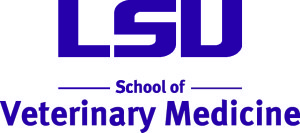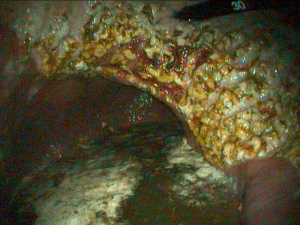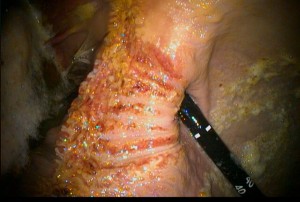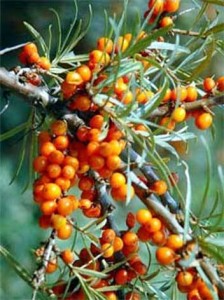Frank M. Andrews, DVM, MS, Diplomate ACVIM
LVMA Equine Committee Professor and Director
Equine Health Studies Program
Department of Veterinary Clinical Sciences
School of Veterinary Medicine
Louisiana State University
Baton Rouge, LA 70803
Email: fandrews@lsu.edu
Original Publish Date August 2014
Gastric (stomach) ulcers are common in horses and can lead to decreased performance, vague clinical signs and may go undiagnosed for months. Stomach ulcers are caused by stomach acids. However, the anatomy of the stomach, diet, restricted feed intake, exercise, stress (stall or transport), and the use of non-steroidal anti-inflammatory agents (NSAIDs; i.e. Bute and Banamine) are risk factors for development of ulcers. Because many factors are involved in their cause, the term Equine Gastric Ulcer Syndrome (EGUS) was coined in 1999 to describe the condition of erosions and ulcerations occurring in the esophagus (food tube), non-glandular (1st part of the stomach), glandular stomach, and proximal duodenum (small intestine). All ages and breeds of horses are susceptible to ulcers and current treatment focuses on blocking stomach acid secretion and raising stomach pH. Drugs are needed to treat these conditions, however, a comprehensive approach including correcting the underlying cause, environmental management, and dietary manipulation is needed for successful prevention.
Horses continuously make stomach acid and acid exposure is the primary cause of ulcers. Also, performance horses are typically fed diets high in grain which can cause or exacerbate ulcers. Stomach bacteria will ferment sugars and produce by-products, such as short-chain fatty acids (acetic, propionic and butyric acids), alcohol, and lactic acid which damages the stomach lining. Several species of bacteria (Lactobacillus, Streptococcus, E. coli) live in the stomach and contribute to ulcer formation. Stomach ulcers in horses are similar to the condition in people called gastroesophageal reflux disease (GERD), which is caused by stomach acid splashing up and damaging the tender esophageal tissue leading to heartburn and ulcers.
Several risk factors for stomach ulcers in horses have been identified. These include exercise (especially high speeds), feeding, diet, stall confinement, and the use of non-steroidal anti-inflammatory drugs (NSAIDs).
Horses in training and racing are at high risk of developing ulcers. Compression of the stomach during running allowed acids from the lower part of the stomach to splash up onto the tender esophageal region of the stomach, a term called “acid splash”, and this leads to ulcers.
Horses grazing at pasture have fewer ulcers. During grazing, there is a continuous flow of saliva and feedstuffs that buffers stomach acid and maintain stomach pH > 4 for a large portion of the day. Conversely, when feed is withheld from horses before competition, stomach acid decreases rapidly and ulcers occur. Studies have shown that stomach pH drops 6 h after feeding, thus horses should be fed hay continuously or every 5 to 6 h to buffer stomach acids.
Diets that are high in grain can lead to ulcers, however, this can be counteracted by feeding alfalfa hay. Alfalfa hay buffers stomach contents and prevents ulcers. This also goes along with stall confinement, as horses that are confined to a stall usually get high grain diets and have limited access to pasture. Mixing alfalfa hay with grass hay is also helpful in preventing ulcers, especially in those horses that get “hot” on alfalfa hay.
Horses with chronic arthritis or lameness that are on NSAIDs (aspirin-like drugs) should be checked frequently, especially if they have vague clinical signs, or at least every 6 months to determine if they have ulcers. Phenylbutazone “Bute” or flunixin meglumine “Banamine” are typically given to control pain but can lead to stomach ulcers if used too long or too frequently. They increase acid secretion and decrease mucus protection in the stomach.
Bacteria (Helicobacter spp.) has not been implicated in stomach ulcers in horses so the use of antibiotics is not indicated as in people with ulcers. However, check with your veterinarian on the use of antibiotics, as he or she may recommend them to treat an underlying infection in some other part of the horse, as ulcers may be secondary to other diseases.
CLINICAL SIGNS (Symptoms)
Clinical signs associated with stomach ulcers are often vague and include partial loss of appetite, mild colic, dull and/or rough hair coat, weight loss, poor performance, change in behavior, and halitosis (bad breath). Ulcers are more common in horses showing clinical signs. Of horses with a client complaint of conditions associated with stomach ulcers, or showing subtle signs of poor health, ulcers were identified in 88-92% compared to 37-52% identified in horse’s not showing clinical signs. In addition to an increased prevalence of ulcers in clinically affected horses, the severity of ulceration is correlated with the severity of the symptoms.
DIAGNOSIS
Diagnosis of EGUS requires a thorough history, identification of risk factors, physical examination, and in some cases blood work. However, gastroscopy (endoscopy of the stomach) is the only sure way to diagnose stomach ulcers. An endoscope is a long tube (6-9 feet) attached to a bright light source with a camera at the end to see inside the stomach and view ulcers (Figure 1).
Figure 1. Endoscopic view of the horse stomach. Note the severe Stomach ulcers in the lesser curvature of a horse with loss of appetite.
Figure 2. Endoscopic view of the same horse after GastroGard® paste treatment. Note the absence of ulcers in the lesser curvature.
When gastroscopy is not available and ulcers are strongly suspected, it may be worthwhile to start empirical treatment and observe for resolution of clinical signs. If the horse does not respond to treatment, further evaluation by your veterinarian is indicated.
MANAGEMENT
The mainstay of pharmacologic treatment of EGUS is to suppress hydrochloric acid (HCl) secretion and increase stomach pH. Because of the high recurrence rate, effective acid control should be followed by nutritional and dietary management strategies to prevent ulcer recurrence.
Omeprazole
Omeprazole paste (GastrogardÒ, Merial Limited, Duluth, GA) is FDA-approved to treat stomach ulcers in horses. There is also a preventative dose of omeprazole paste (UlcerGard®, Merial Limited, Duluth, GA). Consult your veterinarian on which product is best for your horse.
Duration of Treatment
It is difficult to predict how long stomach ulcer will take to heal, but the initial recommended treatment time for omeprazole paste is 28 days. Consult your veterinarian on the length of treatment that is best for your horse. In addition, management changes can help heal ulcers. For example, horses with stomach ulcers should be turned out to pasture and this will, in many cases, result in rapid healing. Treatment with omeprazole paste, in most cases, results if complete healing of stomach ulcers (Figure 2).
Environmental, Nutritional and Dietary Management
Pharmacologic therapy may be necessary to heal stomach ulcers, but ulcers may return within several days if management changes are not instituted. Environmental, nutritional, and dietary management can be initiated during therapy to help facilitate ulcer healing and prevent ulcer recurrence. Adding alfalfa hay to the diet and pasture turn-out facilitate stomach buffering and saliva production, respectively. In addition, several supplements have been used with success to help maintain stomach health once ulcers are healed. These products contain natural ingredients such as sea buckthorn berry, pectin and lecithin, aloe vera, L-glutamine, Slippery Elm, and calcium carbonate.
Figure 3. Sea buckthorn berries (Hippophae rhamnoides) growing in Tibet.
There is an increasing interest in the use of herbs and berries that have therapeutic application in man and animals. Berries and pulp from the seabuckthorn plant (Hippophae rhamnoides) are high in vitamins, trace minerals, amino acids, antioxidants and other bioactive substances (Figure 3). Adding 4 ounces of sea buckthorn berries (SeaBuckTM Complete, Seabuck LLC, Midvale, UT) will help with stomach health and has been shown to prevent an increase in number and severity of stomach ulcers.
There are many supplements on the market containing pectin, lecithin and antacid (calcium carbonate, sodium bicarbonate). The author recently evaluated a supplement containing pectin, lecithin and antacids (Egusin® SLH and 250; Centaur Corporation, Oakland Park, KS). These products, when mixed with sweet feed (4 ounces, twice daily) and fed to horses led to fewer ulcers after 5 weeks of feeding.
In addition, recently a supplement (SmartGut® Ultra) made by SmartPak, Inc., a proprietary mixture of sea buckthorn berries, pectin and lecithin, aloe vera and glutamine reduced the number of ulcers after omeprazole treatment (https://www.smartpakequine.com/pdfs/SmartGut_Ultra_Research_Summary.pdf). This product is ideal to use with and after omeprazole treatment to maintain stomach health. These natural products should not be used to treat stomach ulcers, but as an adjunct to maintain stomach health.
In summary, stomach ulcers are common in horses and leads to vague clinical signs. Feeding more hay and less grain (Figure 3) will help maintain a healthy stomach. Always weight your grain before feeding to make sure you are feeding the correct amount. Remember, consult your veterinarian if you think your horse has stomach ulcers and for the best treatment options.







